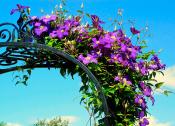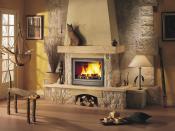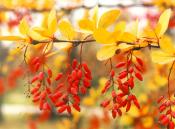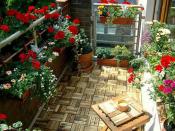Search
Login
Wood wool, what is it, warm floor wood wool
The word wool for us is associated with a widespread animal product, a thread obtained from sheep or goat fur and used in the manufacture of clothing or household items. Of course, wood wool has nothing to do with the aforementioned product, but is wood shavings that are thin and long. A few decades ago, in the countries of the former Union, the production of wood wool was very common, many woodworking machines were set up in such a way that all the waste received during processing did not look like sawdust, but a long chip. Wood wool, the production of which was practiced in each timber industry enterprise, was produced annually in the amount of tens of thousands of tons. Today it is made much less, but still in some sectors of the national economy its application remains a rather urgent issue. The reason for this is versatility, environmental friendliness, ease of disposal, attractive and original appearance.
Content:
- Where and how is wood wool used - wood shavings
- Fiberboard, or panels of wood wool
- The use of fiberboard in construction video
- Troldtekt panels - high sound-absorbing qualities and attractive design video
- Wood Wool Machine video
Where and how is wood wool used - wood shavings
The scope of wood wool is very extensive, firstly, it is an ideal litter that can provide a comfortable content in the cells of many animals.

The size of the shavings does not allow birds or animals to eat it, which can not be said about sawdust. It is preferred by employees of large zoos, motivating their choice with the fact that it is she who can create ideal conditions for captivity in captivity of many species of exotic fauna representatives:
- aromas emitted by wood material remind animals of their natural habitat, making them calmer,
- phytoncides present in the vapors purify the air in the cells from pathogens,
- shavings obtained from hardwoods do not contain phenols, which can have a harmful effect on small predators and rodents.

Given the noble appearance and environmental friendliness of the material, many manufacturers of expensive fruits, alcoholic beverages and simply fragile things prefer it as a packaging material.

She draws gift baskets and boxes, because its appearance is much more aesthetic than foamed polyethylene packaging.
The decorativeness of wood shavings allows you to give an original and presentable look to shop windows, helping to emphasize the high quality of goods.
The industry engaged in the manufacture of building materials also appreciated the heat-saving characteristics of the material, it is actively used:
- in the manufacture of fiberboard slabs, which, after impregnation with bioprotective and fireproofing agents, can protect the house from heat loss over a long period of time,
- ease of storage, low cost and environmental friendliness allow it to be used as the basis for the manufacture of ignition products,
- in a summer house, it is used as mulch when growing strawberries, berry bushes and fruit trees, a layer of such mulch slows down the drying process of the soil, prevents the growth of weeds, keeps fallen fruits from pollution and damage,
- from time immemorial, for the cracking of cracks in wooden ships under construction, they used a braid made of wood wool, with it they cracked cracks between the logs in the construction of outbuildings from wood or log houses.
Fiberboard, or panels of wood wool
Fiberboard slabs are obtained by pressing a magnesian inorganic binder and wood wool.

For the manufacture of fiberboard using chips with the following dimensions:
- thickness 0.3-0.5 mm
- length 2-500 mm
- width 2-5 mm.
To obtain such material, you will need a machine for making wood wool and short pine, spruce or linden logs.
The binding material is Portland cement and a solution of a mineralizer (calcium chloride is used). Due to the use of relatively light wood filler, the boards themselves have a small specific gravity, from 300 to 500 kg per cubic meter, which is already a positive factor.
Such plates are resistant to open fire - cement-soaked chips do not ignite. A variety of fixing materials can be used to assemble fiberglass structures, including dowels, screws and nails, if necessary, the material can be sawn with a conventional saw, and the material can also be drilled easily.

Fiberboard slabs are resistant to putrefactive microorganisms and fungi, their use is permissible in rooms where air humidity does not exceed 75%. Features of the plates allow them to be used as acoustic, structural, insulating and insulating material.
The standard thickness of the plates is from 3 to 5 mm, cement is used as a binder in their manufacture. The scope of such products is the arrangement of the roof and interior partitions, the implementation of thermal insulation.
Acoustic plates are made of very fine chips, often tinted and after installation do not require additional finishing - just choose shades that are in harmony with the tones that define the interior of the room. To obtain white plates, ordinary cement is replaced with a white analog or magnesite.

Composite fiberboard panels have a more solid thickness, 15 - 140 mm, and a layered structure, they can include layers of mineral fibers or rigid foam. The thickness of the layers is usually as follows:
- external - 5 - 20 mm,
- internal - 15 - 140 mm.
Such a structure of the plate suggests a significant increase in heat-saving properties.

Among the advantages of fiberboard plates should be noted:
- ease and simplicity of assembly of structures,
- high warming qualities, up to 0.15 W / (m K),
- mechanical strength
- interesting in terms of decorative appearance
- fire resistance, moisture resistance,
- soundproof properties
- environmental friendliness
- tendency to rot,
- rodents and insects are wound up in the thickness of the plates.
The main disadvantage of the product is its low resistance to bending loads, the allowable effect on the plate on bending is from 0.4 to 1.2 MPa.
The use of fiberboard in construction
wood wool floors
The wood wool used in the manufacture of fiberboard slabs gives them excellent heat-saving qualities, allowing the use of boards as a basis for the arrangement of underfloor heating.

They lay fiberboard for different floor coverings, ranging from linoleum to tile. The advantages of fiberboard slabs as a heater lies in the fact that, with good heat retention, they do not rot, do not collapse from moisture, and do not make creaking sounds, which is very important when covering the floor with linoleum.
Experts consider the cork floor to be the ideal option for a warm floor for a living room. They make it according to two different technologies, one of which involves the installation of plates fastened together. The technique of their installation is similar to laying a laminate. The main layer of such a plate is nothing more than fiberboard, i.e. wood wool. A layer of cork is glued to the surface of the fiberboard. Such panels are stacked in the lock, the finished coating does not have a hard mount to the base of the floor.
fixed formwork
Wood wool, the price of which depends on the size and material of the chip, allows you to produce cheap fiberboard. Lightness of plates, reasonable cost and ease of installation make them an indispensable material used in private construction.

One of the common applications for slabs is the construction of fixed formwork for pouring the foundation. If it is necessary to create a complex curvilinear shape, plates are cut. Work on the construction of formwork is performed without the use of special equipment, which in turn helps to reduce the cost of construction work.
The use of plates allows you to halve labor costs and time for construction work. The use of fiberboard as a formwork is especially effective in winter - constant heating of concrete is not required, the foundation can be poured even at low temperatures.
You can learn more about Green Board fiberboard slabs by watching the video:
Troldtekt panels - high sound-absorbing qualities and attractive design

For more than 75 years, Troldtekt panels made of wood wool have been very successfully used in construction, they are produced in Denmark. Thanks to the continuous improvement of technological processes of production, consumer characteristics of the material are constantly increasing, the product produced today effectively reduces noise and creates a favorable acoustic environment in any, even the noisiest room. High decorative qualities of the material and its environmental friendliness allow the use of plates for finishing ceilings in rooms of any type.

In the production of Troldtekt boards, only wood wool obtained from coniferous wood and white cement are used. When mixed and pressed, they give a sufficiently strong board.

Depending on the length of the shavings used, the Troldtekt panels can be:
- Coarse - chip length 3 mm,
- Fine - from 1.5 mm chips,
- Ultrafine - from 1.0 mm chips.
Attractive points are:
- high degree of plate absorption,
- belonging to the class of slow-burning materials,
- ability to remove echoes
- resistance to mechanical stress, moisture resistance, long service life.
It is worth emphasizing the excellent design characteristics of the plates - they are produced in different sizes and designs, and their surface can be painted in any color. In specialized salons, there are always white plates for sale, the colors of natural light wood and already painted in the most popular shades.

They paint the material directly in the factory with water-based paints. Since the work is performed on high-tech equipment, color uniformity, excellent hiding power and color quality are guaranteed. Coloring of plates can be done in any shade available in the RAL / NCS catalog.
The independent implementation of high-quality coloring of the panels can be a difficult task - it will be necessary to take into account the porous structure of the material. It is recommended to perform the work with a brush with long bristles, if possible - it is better to use a spray gun.
Details of the acoustic plates in the video:
No less interesting decorative material with the same acoustic properties are decorative decorative tiles in the form of hexagons.

They are made in Sweden, used to create bright original interiors.

The multi-colored tiles-bee honeycombs made of wood wool are environmentally friendly, their appearance is pleasing to the eye, touching them is pleasant for the hand.
Wood Wool Machine
And now it's time to learn how to make wood wool. The correctness of the production of chips is determined by GOST 5244. Chipped lumps from low-quality wood, preferably without knots, are used as raw materials, it is not recommended to use a cross-cut. Processing contaminated material is not allowed.

High-quality chips will not work out of knotted chocks:
- its length will be short
- the chips themselves will be too brittle
- there will be a lot of garbage in the chips.
When preparing raw materials, chocks are broken so that the width of the surface from which the chips will be made does not exceed 34 cm. In production, machines for making wood wool are used. The principle of their work can be rotational or straightforward, reciprocating. Do-it-yourself wood wool can be made by planing a reiki with a planer, but this requires skill and patience, as well as patience - the process performed manually is very slow.

When establishing production, SD-3 wood-boring machines are purchased, the principle of operation of which is reciprocating. The cutting part of the unit is a set of planing and dividing knives. The length of the chips produced on such a machine will be equal to the length of the prepared chocks.
The parameters of the resulting chips will depend:
- from the distance between the dividing knives,
- from the protrusion of cutting knives.
You can find out how the wood wool machine works by watching the video:
To obtain high-quality shavings, enterprises practice placing the obtained wool in special drying chambers. Finished products are packaged, each package is equipped with a tag indicating:
- wood species
- bale weight
- wood wool manufacturing enterprise.
Store wood wool in well-ventilated areas, protected from atmospheric precipitation.





